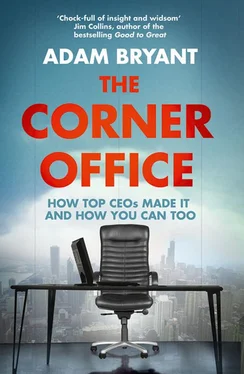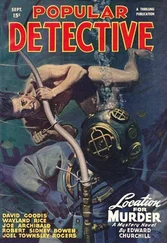Adam Bryant
THE CORNER OFFICE
How Top CEOs Made It and How You Can Too

To Jeanetta, Anna, and Sophia
Daniel P. Amos, CEO, Aflac
Richard Anderson, CEO, Delta Air Lines
Steven A. Ballmer, CEO, Microsoft
George S. Barrett, CEO, Cardinal Health
Carol Bartz, CEO, Yahoo
Gordon M. Bethune, former CEO, Continental Airlines
Greg Brenneman, chairman, CCMP Capital
Bobbi Brown, founder, Bobbi Brown Cosmetics
Tim Brown, CEO, IDEO
Ursula M. Burns, CEO, Xerox
Bill Carter, partner and co-founder, Fuse
Eduardo Castro-Wright, vice chairman, Wal-Mart Stores
John T. Chambers, CEO, Cisco Systems
Cristóbal Conde, CEO, SunGard
Andrew Cosslett, CEO, InterContinental Hotels Group
Susan Docherty, vice president, General Motors
John Donahoe, CEO, eBay
Brian Dunn, CEO, Best Buy
Deborah Dunsire, CEO, Millennium
Jana Eggers, CEO, Spreadshirt
Drew Gilpin Faust, president, Harvard University
William D. Green, CEO, Accenture
Mindy Grossman, CEO, HSN
Omar Hamoui, founder and CEO, AdMob
Steve Hannah, CEO, The Onion
Linda Heasley, CEO, The Limited
Tony Hsieh, CEO, Zappos
Jen-Hsun Huang, CEO, Nvidia
Linda Hudson, CEO, BAE Systems
Robert Iger, CEO, Disney
Judith Jamison, artistic director, Alvin Ailey American Dance Theater
Jeffrey Katzenberg, CEO, DreamWorks Animation
Guy Kawasaki, co-founder, Alltop, and managing director, Garage Technology Ventures
Lawrence W. Kellner, CEO, Continental Airlines
Wendy Kopp, founder and CEO, Teach for America
Jacqueline Kosecoff, CEO, Prescription Solutions
Barbara J. Krumsiek, CEO, Calvert Group
Debra L. Lee, CEO, BET Networks
Niki Leondakis, chief operating officer, Kimpton Hotels and Restaurants
Dawn Lepore, CEO, Drugstore.com
Dany Levy, founder, DailyCandy.com
Terry J. Lundgren, CEO, Macy’s
Susan Lyne, CEO, Gilt Groupe
Sheila Lirio Marcelo, CEO, Care.com
Michael Mathieu, CEO, YuMe
Gary E. McCullough, CEO, Career Education Corporation
Nancy McKinstry, CEO, Walters Kluwer
Nell Minow, co-founder, The Corporate Library
Meridee A. Moore, founder, Watershed Asset Management
Alan R. Mulally, CEO, Ford Motor Company
Anne Mulcahy, former CEO, Xerox
Sharon Napier, CEO, Partners + Napier
Shantanu Narayen, CEO, Adobe Systems
Vineet Nayar, CEO, HCL Technologies
David C. Novak, CEO, Yum Brands
Clarence Otis Jr., CEO, Darden Restaurants
Mark Pincus, CEO, Zynga
Joseph J. Plumeri, CEO, Willis Group Holdings
Lisa Price, founder, Carol’s Daughter
Quintin E. Primo III, co-founder and CEO, Capri Capital Partners
James E. Rogers, CEO, Duke Energy
Kasper Rorsted, CEO, Henkel
Dan Rosensweig, CEO, Chegg
Stephen I. Sadove, CEO, Saks
James J. Schiro, CEO, Zurich Financial Services
Robert W. Selander, CEO, MasterCard
Kevin Sharer, CEO, Amgen
Carol Smith, senior vice president and chief brand officer, Elle Group
Jilly Stephens, executive director, City Harvest
Jeffrey Swartz, CEO, Timberland
Teresa A. Taylor, chief operating officer, Qwest Communications
Kip Tindell, CEO, The Container Store
Will Wright, videogame developer
Tachi Yamada, president, Global Health Program, Bill and Melinda Gates Foundation
For investorsand business journalists, stock-price fluctuations and quarterly results offer a steady stream of report cards for evaluating a CEO’s work. And then, every spring, when proxy season rolls around and companies disclose the compensation packages for top executives, another round of report cards begins. This transparency keeps people honest and creates a relatively level playing field (except, of course, when the numbers lie). From these data, a story line emerges around the CEOs as strategists, and we focus on their successes, their failures, their challenges. Have they sized up the industry landscape correctly and developed a plan to beat their competitors? Are they executing this plan in a disciplined fashion?
For this book, I was interested in pursuing a different story line about CEOs – their own personal stories, free of numbers, theories, jargon, charts, and with minimal discussions of their companies or industries. I wanted to hear what they had learned from their ups and downs, their stories about how they learned to lead, the mistakes they made along the way, how they fostered supportive corporate cultures, and how they do the same things that every other manager does – interview job candidates, run meetings, promote teamwork, manage their time, and give and get feedback.
While setting overall business strategy is certainly an important part of a CEO’s job, leadership shapes every part of their day. Once they have a plan, the challenge becomes making sure they have the right people on the team, and getting the most out of them and the broader organization. CEOs may not study leadership in books or develop new silver-bullet theories, but they are experts in leadership because they practice it daily. And many of them have spent the better part of a decade or more honing their leadership styles, through trial and error, studying what works and what doesn’t, and then mentoring others.
CEOs have learned firsthand what it takes to succeed and rise to the top of an organization. From the corner office, they can watch others attempt a similar climb, and notice the qualities that set people apart. As they evaluate talent, they learn to divine why one person is more likely to succeed than another. When they bring in talent from the outside, they watch as some new hires blend in better than others. Who succeeds? Who fails? Why? It’s a feedback loop that expands with every additional person they manage, creating a kind of laboratory for studying the qualities that enable people to succeed. CEOs study team dynamics, too. If one division or group consistently outperforms another, why is that? What leadership skills does that division or group leader possess? Finally, there is feedback from the marketplace. In business, there are constant judgments and scores. From quarter to quarter, CEOs can determine whether their strategies and leadership styles are working, and whether they need to be adjusted.
CEOs face criticism from many corners, and it is often deserved. But there is no arguing that they have achieved a great deal, through a combination of smarts, hard work, attitude, and commitment. They have much to offer beyond a return on a shareholder’s investment.
I have spent much of my two decades in business journalism interviewing CEOs and asking variations of the question “What’s the strategy for your company?” But I found myself growing more interested in asking them questions like “How do you do what you do?” “How did you learn to do what you do?” and “What lessons have you learned that you can share with others?”
I developed an appreciation for what effective leadership can mean for a company – and the skills a CEO brings to the table – when I covered the airline industry in the mid-1990s as a reporter for the New York Times . It was a particularly turbulent time in the business, and some of the executives running the carriers were larger-than-life characters. The airline industry, I realized, was like the National Football League. There are team colors and logos – and people have strong passions about which teams they love and hate. Each team has roughly the same equipment, and, as in football, the playing field is reasonably level. One airline can instantly copy an effective strategy from a competitor, whether it’s a fare sale or a new twist to the frequent-flyer program. Like defensive and offensive players in football, the employees of each airline are organized into their own specialized units – pilots, flight attendants, mechanics, baggage handlers, gate agents, white-collar workers. I found that what really made the difference from one airline to another was leadership. The culture and tone started at the top, and each company reflected the personalities of its CEO, whether it was Robert L. Crandall at American, Herb Kelleher at Southwest, Stephen M. Wolf at United, or Gordon M. Bethune at Continental. The leader who understood how to get his employees to work together as a team had an advantage.
Читать дальше













